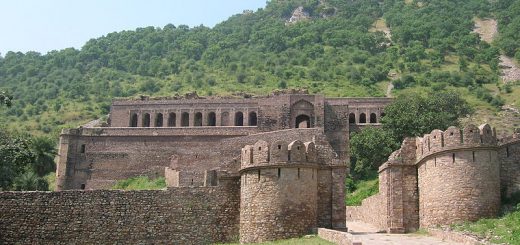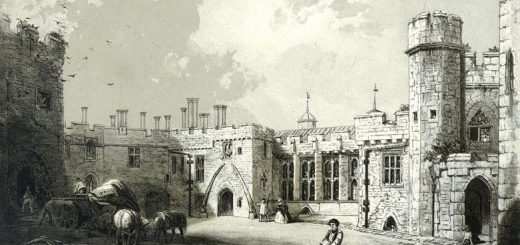Carlisle Castle
This building is reputed to be haunted by a ghostly woman. A soldier in 1823 was so frightened when he encountered her, that he bayoneted the apparition, impaling the wall behind it. The soldier fainted and died of shock the following day.
In 1820 a woman clothed in tartan was supposedly discovered bricked up in the Captains Tower on a staircase. She was holding a young child and her costume apparently dated back to Elizabethan times.
The building within the castle which used to house the Kings Own Border Regiment Museum was the scene of a reported strange experience. Alarms were set off three nights in a row during 1992, indicating something moved under the arch between the downstairs exhibition and gift shop/main desk area.
The building the museum occupied dates from the 19th century and stands beside the magazine and militia store. Before their construction, there was a single range building in this area which comprised of royal apartments, a great hall and a chapel
Directions: Carlisle is reached from the M6 heading North and the A74 heading South, the Castle is not far from the town centre near the Cathedral. The castle is in the care of English Heritage, there is an entry fee.





Re: Carlisle Castle
According to a newspaper article by Sarah Newstead that appeared in the News & Star on 28 September 2011 entitled ‘Is Cumbria The Most Haunted?’
Although the “ghosts” at the castle are said to be pretty friendly, Frederick Graham, of Dalegarth Avenue, Harraby, had a different tale to tell. He says: “As a serving soldier of the Border Regiment I was sleeping alone on the ground floor of the Arroyo Billet, Christmas 1954.
“During the night I was attacked by a ghost which was intent on strangling me, and it very nearly did.
“It was the most horrific night of my life and I remember it to this day.”
Re: Carlisle Castle
http://hauntedearthghostvideos.blogspot.com/2012/01/ghostly-boy-captured-in-haunted-castle.html?spref=fb
Re: Carlisle Castle
HAS CARLISLE CASTLE’S ‘GHOSTLY BOY’ BEEN CAPTURED IN A PHOTO?
A ghostly child thought to haunt Carlisle’s former archive centre may finally have been captured on film.
The thin little boy has often been spotted at the 80 year old building, hidden within the walls of Carlisle Castle. Standing in the doorway to an old caretaker’s flat, he is said to create a chill in the air.
The former army building, called Alma block, is soon to be the new site of Carlisle’s Border Regiment Museum. Earlier this month, surveyors sent a picture of what looked like the ghost to assistant curator Tony Goddard.
Mr Goddard, who has long been fascinated by the paranormal, said: “I’ve been saying all along there’s a little boy standing in the doorway. He looks drawn, he looks unwell. I believe he must have died from consumption.
“Then an independent person sends me a photo and there he is.”
Since he started working at Alma block in January, Tony has witnessed a catalogue of ghostly happenings. He’s seen shadowy figures and heard the sound of a piano coming from the empty upper floors.
He added: “They don’t make you feel afraid. There’s no sense that they’re trying to frighten you or they don’t want you there. Quite the opposite, in fact. Alma block was built by the regiment and obviously, we’re moving back in.”
And the spooks are just as obvious in the afternoon as in the dead of night.
“A popular misconception with ghosthunting is that it has to be dark,” he said. “They’re there all the time. But they don’t want to hurt you – they won’t do anything to you in death that they wouldn’t do in life.”
The block once provided a canteen and library rooms for soldiers of the King’s Own Royal Border Regiment. It became a storage site for the archive service in 1960, when rows of plastic racking were installed on most of the walls.
Once dismantled by Tony and his team, they revealed original fittings including a mahogany bar.
It’s not the first time that Carlisle Castle has generated ghost stories.
In 2009, the castle was investigated by Most Haunted team from Living TV.
Among the stories that brought them there was that of a ghostly woman who reputedly stalks the corridors.
It is claimed that in 1823, her apparition frightened a soldier so badly that he bayoneted it, impaling the wall behind it.
He is alleged to have then fainted and died of shock the following day.
First published at 12:56, Thursday, 09 June 2011
Published by http://www.newsandstar.co.uk
Re: Carlisle Castle
GHOSTLY FIGURES SIGHTED AT CARLISLE’S NEW HAUNT?
By Phil Coleman
News & Star Tuesday, 01 February 2011
There was a distinct chill in the air as Tony Goddard recalled recent events in his new workplace…
Hidden behind the ancient walls of Carlisle Castle, this 80-year-old building once provided a canteen and library rooms for soldiers of the King’s Own Royal Border Regiment.
But since 1960, it has provided storage space for the county’s archive service.
The building is now being prepared for yet another role – as the new HQ for the Castle’s Border Regiment Museum.
But since beginning work there, says Mr Goddard, the museum’s assistant curator, he has been shocked by a catalogue of ghostly happenings.
They have included:
Shadowy figures lurking in doorways and rooms;
Unexplained bangs and footsteps hurrying away;
Small objects flying through the air;
Lights turning themselves on overnight;
The sound of a ghostly piano coming from the empty upper floors.
Mr Goddard, who has long been fascinated by the paranormal, said: “The building is called Alma block, and we’ve been working here since January 10, and there have been lots of strange things.
“One of the strangest was when three of us were sitting in the staff room, and I know there was nobody else in the building because there’s only one way in.
“But we heard the sound of somebody banging on the internal door.
“When we opened it, there was nobody there, but we heard footsteps running up the steps to the first floor.
“Last week, I was working on some shelving and I had the feeling I was being watched. So I turned round. Through the window to the room next door I could see the figure of a man, just standing there, looking at me. I just said ‘you don’t frighten me’ and I turned round.”
At other times, said Tony, washers have been thrown at him from above – when nobody else was in the room and another time he heard the sound of a piano, though there is not one anywhere near.
One of the most disturbing stories has been about the image of a boy seen standing near the entrance to the old caretaker’s flat on the building’s upper floor.
The gloomy doorway is known to be markedly colder than nearby rooms.
It is not the first time that Carlisle Castle has generated ghost stories.
In 2009, the castle was investigated by Most Haunted team from Living TV.
Among the stories that brought them there was that of a ghostly woman who reputedly stalks the corridors. It is claimed that in 1823, the apparition frightened a soldier so badly that he bayoneted the spook, impaling the wall behind it. He is alleged to have then fainted and died of shock the following day.
Re: Carlisle Castle
[Magna Britannia: volume 4: Cumberland (1816) – by Daniel and Samuel Lysons]
Carlisle Castle is pleasantly situated at the north-west corner of the ancient walls of the city, on a steep bank, overlooking the Eden. The tower commands a rich and extensive prospect. This castle was probably the residence of the several royal personages, whose visits to Carlisle have been already spoken of. It was built, or rather begun to be built, as before stated, in the reign of William Rufus; in the reign of Henry III. it was in a very dilapidated state, in consequence of the damage done to it when besieged by Alexander, the Scottish King, in 1216, and which had not been repaired in the year 1256, as appears by the return to a commission of inquiry, directed to Sir Thomas de Lascelles and others. In this return the queen’s chamber, Maunsell’s turrett, the turrett of William de Ireby, the chapel, great hall, kitchen, and other offices, are represented as in a state of great decay. Having been in the mean time the object of frequent attack, when an estimate of its repairs was made in the year 1344, the expence of repairing the stone work was stated at 200l.; the wood work in the great tower, the great hall, and other buildings, at 100 marks; the repairs of the stone work of the walls, turrets, kernels, and gates, was estimated at 200l. the wood work at 100l. In the reign of Queen Elizabeth the castle appears to have been in a very ruinous condition. It is stated in a survey, made in consequence of a commission of inquiry in 1563, that the dungeon tower, (which should be the principal defence of the castle) was in a state of great decay; and although the walls were twelve feet thick, was in daily danger of falling; that there was a breach in the outer ward (made by a fall of the wall in 1557) sixty-nine feet and a half in length, which wall had been nine feet thick and eighteen in height; the captain’s tower also, and the gates, were much decayed. The great chamber and hall are spoken of in this survey. Upon this report the castle was ordered to be put in a state of repair. It appears that it was of sufficient strength in the middle of the following century to stand a siege of several months.
Among the governors of Carlisle in the reigns of Henry III. and the three Edwards, we find John Baliol and Robert Bruce, the younger, both afterwards Kings of Scotland, William de Fortibus, Earl of Albemarle, Peter de Gaveston, the favourite of King Edward II. Andrew de Hercla, Earl of Carlisle, and John Halton and John Kirkby, successively Bishops of Carlisle. A small garrison is still kept in the castle; the present governor is Major General R. Burne.
The castle is the site of the ancient royal manor of the socage of Carlisle, partly within the city, and extending over 500 acres of land in its immediate vicinity. This manor was demised by Queen Elizabeth, at the beginning of her reign, to Henry Lord Scrope, Lord Warden of the Marches; and after his death to George Clifford, Earl of Cumberland. The lease was subsequently vested for several generations in the noble family of Howard, Earl of Carlisle, but the Duke of Portland having succeeded in his claim to this manor under King William’s grant, as parcel of the forest of Inglewood, it was included in the late Duke of Devonshire’s purchase in 1787, and is now the property of the present duke. During the interregnum the inheritance of this manor was sold to Mr. Craister of Carlisle, but of course it was resumed by the crown at the restoration.